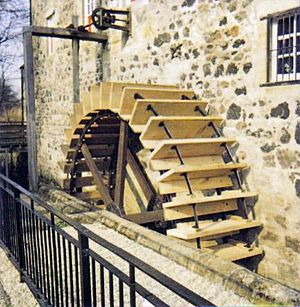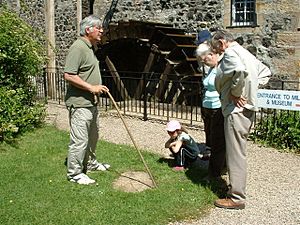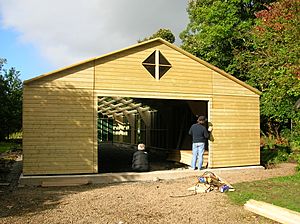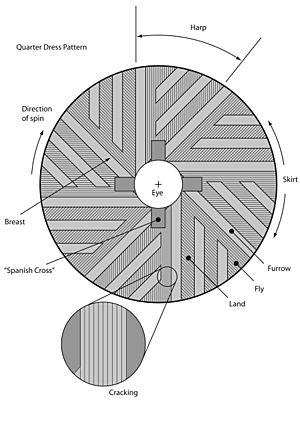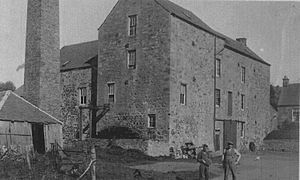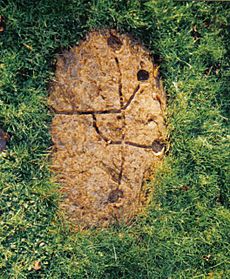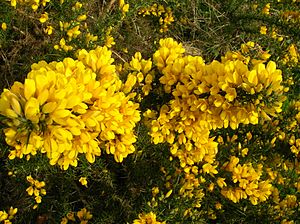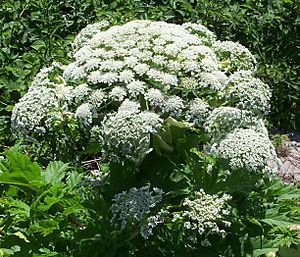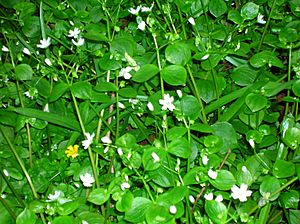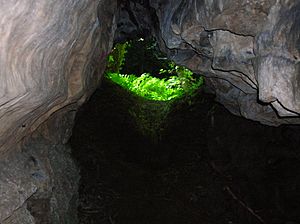Dalgarven Mill – Museum of Ayrshire Country Life and Costume facts for kids
Dalgarven Mill is a special place near Kilwinning in North Ayrshire, Scotland. It's home to the Museum of Ayrshire Country Life and Costume. This old watermill has been carefully fixed up and is now run by a group of volunteers called the Dalgarven Mill Trust.
The mill buildings are a popular spot for visitors and a great place to learn about local history. They show what life was like in Ayrshire a long time ago. Not many old mills are left in Ayrshire, so Dalgarven Mill is a real treasure! Some of the smaller buildings around the mill have been turned into an antique shop, and others are being made ready for visitors.
The family of the last miller, the Fergusons, still help run the museum. They work with a team of volunteers. Dalgarven Mill is a four-star visitor attraction in Ayrshire, known for its interesting displays.
Contents
Dalgarven Mill's Story
People have used this spot for a mill since the 1300s! The first mill was a "waulk mill," which helped make woollen cloth. They used to soak plant stems like flax in water here to get fibres for making linen and other things.
The mill you see today was built in 1614 to grind corn. It was rebuilt in 1880 after a fire. The River Garnock's water powers a huge 6-meter wide waterwheel. This wheel turns big "French burr millstones" that grind the grain into flour.
You can see how flour was made in the old days when you visit. The waterwheel often turns, especially since it got new wooden parts between 2006 and 2009.
The water channel, called a "lade," was very important for the mill to work well. It brought water from the river to the wheel.
A stone wall, called a weir, in the River Garnock creates a small pond. This pond holds enough water to send to the mill wheel. The monks from Kilwinning Abbey were smart to build the mill here because of a natural rock barrier in the river that helped create this water supply.
Long ago, mills often had trees or walls to shade the waterwheel from the sun. This was because if the wooden wheel dried out too much when it wasn't moving, it could warp and break. At Dalgarven, high walls originally protected the wheel.
The Dalgarven waterwheel is a "low breastshot" wheel, meaning the water hits it low down. It turns counter-clockwise. Each bucket on the wheel has a special "sacrificial board." If something gets stuck, this board breaks off first, protecting the rest of the wheel and the grinding stones from damage.
In the 1940s, the miller even used the waterwheel to make electricity for the mill! Today, the museum is looking into using the wheel to make electricity again, helping the environment.
The mill building has a unique feature: a small alcove designed for owls to nest in. The owls would then hunt mice and other pests that were attracted to the stored grain.
You might notice the mill building doesn't have many windows. This was partly practical, but it might also have been to avoid paying a "window tax" that existed long ago. This tax meant people paid more money if their house had more windows!
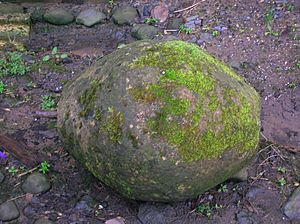
Outside the old mill, there's a large oval stone with metal parts. This stone was used to crush tough plants like gorse (also called whin). A horse would drag the stone around in a shallow trough, making the spiny plant soft enough for animals to eat, especially when other food was scarce.
You can learn more about the mill's history in a book called A Miller's Tale. The Life and Times of Dalgarven Mill, written by Robert Ferguson, the son of the last miller.
Old Laws and Mills
Long ago, there was a feudal law called "Thirlage". This law forced farmers living on a lord's land to bring their grain to his mill to be ground. They also had to help fix the mill and carry new millstones to it.
This law was removed in 1779. After that, many mills closed because they couldn't compete or afford to run without the guaranteed business.
The Museum of Country Life
The mill's three-story grain store has been turned into a museum. It holds a huge collection of old farming tools and household items from Ayrshire. These displays show how people lived and worked before modern factories. You can see exhibits about ploughing, threshing, harvesting, and the village smithy. There's also an antique shop and a cafe for visitors.
Exploring the Museum and Mill
The River Garnock
The River Garnock has powered Dalgarven Mill for hundreds of years. A special wall (weir) and channel (lade) guide the river's water to the big waterwheel.
Outside the Mill
Inside the Mill
The inside of the mill buildings has been completely restored. They used to be in ruins!
Exhibition Areas
An upper floor of the mill has different areas that show what Victorian homes looked like.
Costume Collection
The mill has a huge collection of old clothes and costumes from different times and people. You can see parts of this collection displayed on the ground floor. The exhibitions change often, so there's always something new to see! The costumes are also used for school visits and special events.
Country Life in the Past
The first and second floors of the mill show all sorts of things about country life. You can see recreated rooms from Victorian times, like a parlour, kitchen, and bedroom. There are also displays of farm tools, lace, luggage, dairy equipment, and even early vacuum cleaners and washing machines. You can also see a recreated "cottar's house," which was a simple home for a farm worker.
On each floor, you can see the restored mill machinery, like the hoppers and grindstones. On the ground floor, there's an exhibition showing all the hard work that went into bringing the mill back to life.
Outside, you'll find interesting items like an old cast-iron milestone and different types of ploughs.
Education
School groups often visit the mill to learn. They get guided tours and talks on many topics, from river life and wildflowers to geology and how the waterwheel works. It's a great place to learn about sustainability!
Other Interesting Things to See
Ancient Stone Carvings
There's a copy of a special stone carving called a cup and ring mark stone on display. The original stone was found near Dalgarven. These carvings are very old, possibly from the Stone Age or Bronze Age, up to 6000 years ago! No one knows exactly why they were made. The Dalgarven copy is unusual because it has cups and connecting lines, but no rings.
Fossils
Sometimes, you can find fossils in the river's limestone boulders. These fossils are from ancient tree ferns that grew millions of years ago when Scotland had a warm climate. These plants were much taller than ferns today and helped create Scotland's coal deposits.
Riverside Walk
Take a walk along the beautiful River Garnock. In spring, the wildflower meadows are lovely. In summer, you might spot herons, swallows, or even a kingfisher by the river. There's also a Community Woodland that you can explore.
The river's gravel bed used to be important for the millers, who had the right to collect and sell the gravel.
You might find a plant called pignut in the meadows. It's related to parsley, and children used to dig up its small, potato-like root for a snack. It tastes a bit nutty!
Be careful of some plants like Hemlock water dropwort and Giant hogweed. Their sap can cause skin problems, so it's best not to touch them. Local groups like Ayrshire Rivers Trust work to control these plants.
Another interesting plant is the Stewarton flower, or pink purslane. It has white or pink flowers. Dalgarven is also the only known place to find a special plant disease called pocket plum gall on bird cherry trees.
You'll see alder trees along the river. Their wood was used for building and fencing. Millers especially needed strong wood like beech or hornbeam for the gears in the mill machinery.
It's amazing how much the landscape has changed. A few hundred years ago, there were hardly any trees or hedges in this area!
Countryside Walks and Cycle Paths
You can find leaflets at the mill that describe different walks. The Sustrans cycle path, which goes from Irvine and Largs to Glasgow, passes nearby. Cyclists often stop at the mill for a break. You can also walk to the interesting Cleeves Cove cave system in the Dusk Glen from the mill.
Geocaching Fun
If you like geocaching, there's a hidden cache on the nature walk! You'll need a GPS to find it. It's a fun way to explore interesting places.
Blair House
Blair House, a historic home, is close by. It was once known for being occupied by the same family for a very long time in Scotland, until they sold it in 2012.
See also
- Nether Mill
- Ballochmyle cup and ring marks
- Barburgh Mill
- Coldstream Mill
- Cunninghamhead
- Meikle Millbank Mill
- Cup and ring mark
- Museum of Scottish Country Life
- Staddle stones
- A Researcher's Guide to Local History terminology



